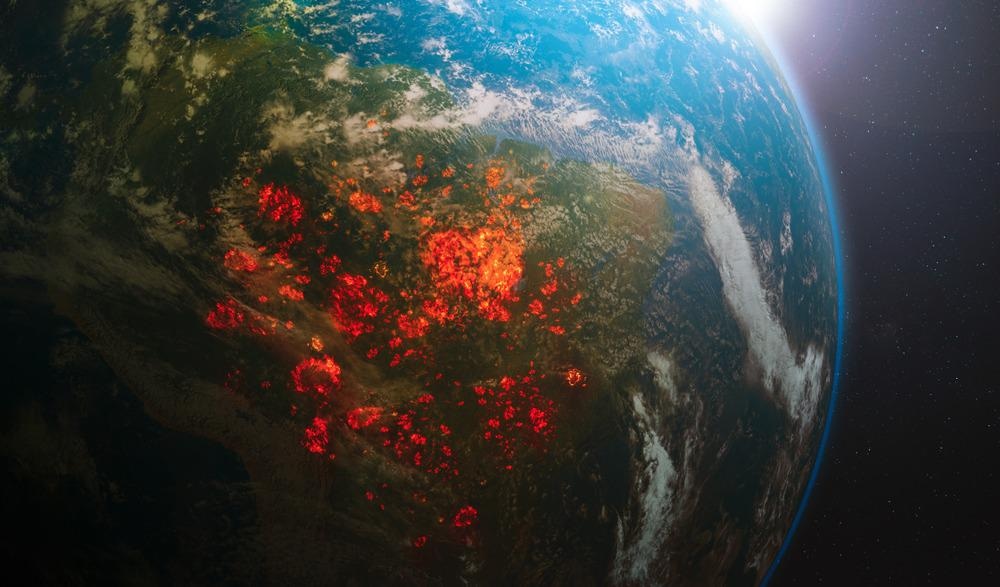Forest fires are increasing in prevalence, damaging ecosystems, and costing lives. Early detection systems are vital to preventing the detrimental impact of these fires that rapidly spread across landscapes. Over recent years, several optical systems have been developed that can act as early warning systems. We discuss these processes below.

Image Credit: OSORIOartist/Shutterstock.com
Forest Fires: A Result and Cause of Global Warming
In recent years, forest fires have been increasing in frequency, duration, and extent of burning.
Increased global temperatures, harsher droughts, and the availability of water in the soil are all factors affected by climate change that also contribute to the risk of forest and wildfires.
In April 2020, data revealed that forest fires had increased by 13% from 2019, which was already a record-breaker for fires.
Climate change is undoubtedly increasing the threat of wildfires and, unfortunately, this relationship is mutual, with wildfires releasing an incredible amount of carbon dioxide CO2 into the atmosphere, further promoting climate change.
The impact of forest and wildfires is devastating not only to the climate but to people and wildlife too.
It is vital that new methods of early detection are established so that fires can be put out when they are small and easy to manage, before they have devastated the landscape and the species inhabiting it, before residents have lost their homes and even their lives, and before tons of CO2 is released into the atmosphere.
New research into photonics is helping to develop early warning systems to alert emergency services to forest and wildfires early on. These systems will likely be fundamental to tackling the increasing danger presented by these fires and will hopefully contribute to tackling climate change by reducing the emissions associated with them.
Applications of Optical Technology in the Early-Detection of Forest and Wildfires
Scientists have developed the use of various sensors in a wide range of applications in almost every industry. Advances in sensor technology, alongside camera and computer technology, have resulted in the establishment of numerous detection sensors that can recognize a forest or wildfire at its early stages so that it can be stopped before significant damage and loss of life is caused. Here, we discuss the various optical methods of early detection of forest or wildfires.
Detecting smoke with video cameras and algorithms
Much research and development have focused on creating a system based on video cameras that can automatically detect smoke during the day and fire at night.
Scientists have programmed algorithms that can detect different factors in their field of view that relate to fires, including slow-moving objects, detection of bright regions, detection of objects that exhibit periodic motion, as well as sub-algorithms to interpret the motion of regions of the field of view.
Each of these sub-algorithms is programmed to detect different aspects of fire. These algorithms have been coupled with pan-tilt-zoom (PTZ) cameras to reliably detect fire, with a least-mean-square (LMS) based decision fusion approach utilized to calculate individual decisions on the data provided. A decision of fire or no fire is achieved via an active learning method.
Infrared cameras for early-warning fire detection
Infrared cameras have also been a point of focus for research into the development of early warning systems for forest fires.
Infrared cameras detect the heat of objects, making them particularly useful for fire identification. Some infrared cameras sense minute changes in temperature, down to differences of just 0.01 °C, making them more than capable of detecting the presence of fire before it is visible to the naked eye.
Infrared camera technology has also been developed to identify the spectral characteristics of smoke. If heat cannot be detected, infrared cameras can be used to recognize patterns that are associated with the smoke from forest fires.
Light detection and ranging (LIDAR) is an optical method using pulsed lasers to measure distances between the origin and the laser and the object it meets. One of the first applications of this optical technology was to monitor the smoke produced by factories, providing a fire safety system. LIDAR works in a similar way to detect wildfires. The laser rays reflect from the smoke produced by the fire, providing a reliable early detection method.
Other innovative optical systems have also been established. Some based on cameras have been coupled with algorithms that track how many pixels contain smoke or the glow of a fire. The processing unit then sends these results to another algorithm, which makes the choice on whether to sound the alarm.
The Future of Optical Techniques to Fire Prevention
Optical systems are vital for the future prevention of forest and wildfires. As we begin to experience the more severe effects of climate change, it is important that we tackle them.
Optical systems can not only prevent the impact of climate change, but they can also mitigate climate change itself by preventing tons of CO2 from entering the atmosphere from uncontrolled forest fires.
References and Further Reading
Alkhatib, A., 2014. A Review on Forest Fire Detection Techniques. International Journal of Distributed Sensor Networks, 10(3), p.597368. https://journals.sagepub.com/doi/full/10.1155/2014/597368
Fires, forests, and the future: a crisis raging out of control. [Online]. WWF. Available at: https://wwf.panda.org/discover/our_focus/forests_practice/forest_publications_news_and_reports/fires_forests/ (Accessed 8 October 2021)
Günay, O., Taşdemir, K., Uğur Töreyin, B. and Enis Çetin, A., 2009. Video based wildfire detection at night. Fire Safety Journal, 44(6), pp.860-868. https://www.sciencedirect.com/science/article/abs/pii/S0379711209000496
Wildfires and Climate Change. [Online]. Center for Climate and Energy Solutions. Available at: https://www.c2es.org/content/wildfires-and-climate-change/ (Accessed 8 October 2021)
Disclaimer: The views expressed here are those of the author expressed in their private capacity and do not necessarily represent the views of AZoM.com Limited T/A AZoNetwork the owner and operator of this website. This disclaimer forms part of the Terms and conditions of use of this website.